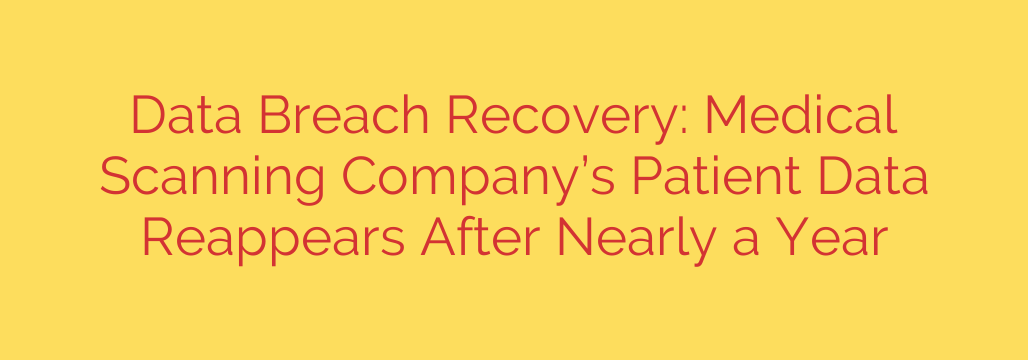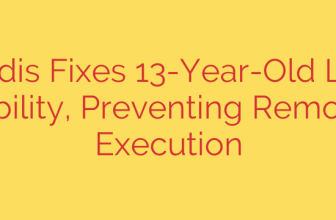
Stolen Medical Data Resurfaces: A Sobering Reminder of Long-Term Breach Risks
When a data breach occurs, the immediate aftermath is often a flurry of activity: public notifications, apologies, and offers of credit monitoring. For those affected, there’s a period of high alert, followed by a gradual return to normalcy as the incident fades from the headlines. However, a recent event serves as a critical reminder that a data breach is not a single point in time—it’s a lingering threat with a very long tail.
In a chilling development, a massive trove of sensitive patient data stolen from a medical scanning company has reappeared on the dark web nearly a year after the initial attack. This incident underscores a dangerous reality in the world of cybersecurity: stolen data doesn’t just disappear. It often goes underground, waiting for the right moment to surface and cause maximum damage.
The Lifecycle of Stolen Data
Cybercriminals operate with strategic patience. After a successful breach, they may not leak or sell the stolen information immediately. There are several reasons for this delay:
- Failed Ransom Negotiations: The data may have been held hostage during a ransomware attack. If the victim organization refuses to pay, attackers may hold onto the data, waiting for a later opportunity to monetize it.
- Maximizing Value: Cybercriminals may wait until public attention has died down, believing victims will be less vigilant. They might also bundle the data with information from other breaches to create more valuable packages for sale.
- Avoiding Detection: A massive, immediate data dump can attract significant attention from law enforcement and cybersecurity firms. A delayed release can make it harder to trace the activity back to the original attackers.
The key takeaway is that the absence of leaked data following a breach does not mean the threat has been neutralized. The information is often quietly held in criminal circles, a ticking time bomb waiting to be detonated.
Why Medical Records Are a Prime Target
Medical data, or Protected Health Information (PHI), is exceptionally valuable on the dark web—often worth more than financial data like credit card numbers. This is because it contains a rich combination of personally identifiable information (PII) that is difficult, if not impossible, to change.
A stolen medical file can include:
- Full Names and Addresses
- Dates of Birth
- Social Security Numbers
- Insurance Policy Information
- Detailed Medical Histories and Diagnoses
This comprehensive information is a goldmine for criminals, enabling sophisticated fraud, from filing false insurance claims to obtaining prescription drugs illegally and even committing wholesale medical identity theft. The permanent nature of this data means its value does not diminish over time, making it a persistent risk for patients.
The Long-Term Consequences for Patients and Providers
The reappearance of stolen patient data creates a renewed wave of risk for everyone involved.
For patients, the dangers are significant and long-lasting. They face the immediate threat of financial fraud and identity theft. Furthermore, the exposure of sensitive medical conditions can lead to personal embarrassment, discrimination, or even blackmail.
For healthcare providers, the reputational damage can be catastrophic. A breach erodes patient trust, which is the cornerstone of the healthcare relationship. Beyond reputational harm, organizations face severe regulatory penalties, including massive fines under HIPAA, and the potential for costly class-action lawsuits. The reappearance of data long after an incident can trigger new legal and financial liabilities.
Actionable Security Tips: Protecting Yourself in the Wake of a Breach
If you’ve been notified that your data was part of a breach—especially a healthcare-related one—it’s crucial to remain vigilant indefinitely. Here are steps you can take to protect yourself:
Freeze Your Credit: This is one of the most effective actions you can take. A credit freeze restricts access to your credit report, making it much more difficult for identity thieves to open new accounts in your name. Contact each of the three major credit bureaus (Equifax, Experian, and TransUnion) to place a freeze.
Scrutinize Your Medical Statements: Carefully review every Explanation of Benefits (EOB) statement from your insurer and any bills from providers. Look for services, prescriptions, or equipment you did not receive. Report any suspicious activity immediately to your insurance company.
Be Wary of Phishing Attacks: Criminals will use your stolen personal and medical information to craft highly convincing phishing emails, text messages, or phone calls. Be skeptical of any unsolicited communication asking for more information or urging you to click a link, even if it seems to be from a legitimate healthcare provider.
Strengthen Your Passwords: Ensure you are using strong, unique passwords for all your online accounts, especially for patient portals and insurance websites. Enable multi-factor authentication (MFA) wherever it is offered for an essential layer of extra security.
Ultimately, the delayed release of stolen medical data is a stark illustration that in cybersecurity, the past is never truly past. For both organizations and individuals, proactive and persistent security measures are not just recommended—they are essential for navigating today’s complex threat landscape.
Source: https://go.theregister.com/feed/www.theregister.com/2025/10/07/10_months_later_us_medical/








